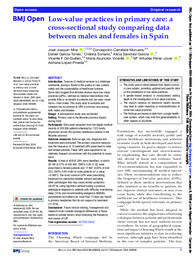Por favor, use este identificador para citar o enlazar este ítem:
https://hdl.handle.net/11000/34912Registro completo de metadatos
| Campo DC | Valor | Lengua/Idioma |
|---|---|---|
| dc.contributor.author | Mira, José Joaquín | - |
| dc.contributor.author | Carratalá‐Munuera, Concepción | - |
| dc.contributor.author | García-Torres, Daniel | - |
| dc.contributor.author | Soriano, Cristina | - |
| dc.contributor.author | Sánchez-García, Alicia | - |
| dc.contributor.author | Gil-Guillen, Vicente F. | - |
| dc.contributor.author | Vicente, María Asunción | - |
| dc.contributor.author | Pérez-Jover, Virtudes | - |
| dc.contributor.author | Lopez-Pineda, Adriana | - |
| dc.contributor.other | Departamentos de la UMH::Psicología de la Salud | es_ES |
| dc.date.accessioned | 2025-01-18T09:56:17Z | - |
| dc.date.available | 2025-01-18T09:56:17Z | - |
| dc.date.created | 2024-11 | - |
| dc.identifier.citation | BMJ Open 2024;14 | es_ES |
| dc.identifier.issn | 2044-6055 | - |
| dc.identifier.uri | https://hdl.handle.net/11000/34912 | - |
| dc.description.abstract | Introduction Overuse of medical services is a challenge worldwide, posing a threat to the quality of care, patient safety and the sustainability of healthcare systems. Some data suggest that females receive more low- value practices (LVPs)—defined as medical interventions that provide little or no benefit to patients and can even cause harm—than males. This study aims to evaluate and compare the occurrence of LVPs in primary care among both males and females. Design A retrospective study was conducted. Setting Primary care in the Alicante province (Spain) during 2022. Participants Data were extracted from the digital medical records of 978 936 patients attended by 1125 family physicians across 262 primary healthcare centres in the Alicante province. Outcome measures Data on age, sex, diagnosis and treatment were extracted. The primary outcome measure was the frequency of 12 selected LVPs prescribed to male and female patients. These LVPs were expected to be relatively frequent occurrences with the potential to cause harm. Results A total of 45 955 LVPs were identified, of which 28 148 (5.27% of 534 603, CI95% 5.20–5.32) were prescribed to female patients and 17 807 (4.00% of 444 333, CI95% 3.95–4.06) to male patients (x², p value <0.0001). The most common LVPs were prescribing treatment for overactive bladder without excluding other pathologies that may cause similar symptoms (30.87%), using hypnotics without having a previous aetiological diagnosis in patients with difficulty maintaining sleep (14%) and recommending analgesics (NSAIDs, paracetamol and others) for more than 15 days per month in primary headaches that do not respond to treatment (13.33%). Conclusions Future clinical training, management and research must consider biological differences or those based on gender factors when analysing the frequency and causes of LVP. | es_ES |
| dc.format | application/pdf | es_ES |
| dc.format.extent | 11 | es_ES |
| dc.language.iso | eng | es_ES |
| dc.publisher | BMJ Publishing Group | es_ES |
| dc.rights | info:eu-repo/semantics/openAccess | es_ES |
| dc.rights | Attribution-NonCommercial-NoDerivatives 4.0 Internacional | * |
| dc.rights.uri | http://creativecommons.org/licenses/by-nc-nd/4.0/ | * |
| dc.subject.other | CDU::1 - Filosofía y psicología::159.9 - Psicología | es_ES |
| dc.title | Low- value practices in primary care: a cross- sectional study comparing data between males and females in Spain | es_ES |
| dc.type | info:eu-repo/semantics/article | es_ES |
| dc.relation.publisherversion | https://doi.org/10.1136/ bmjopen-2024-089006 | es_ES |

Ver/Abrir:
10.e089006.full (1).pdf
442,1 kB
Adobe PDF
Compartir:
 La licencia se describe como: Atribución-NonComercial-NoDerivada 4.0 Internacional.
La licencia se describe como: Atribución-NonComercial-NoDerivada 4.0 Internacional.
.png)